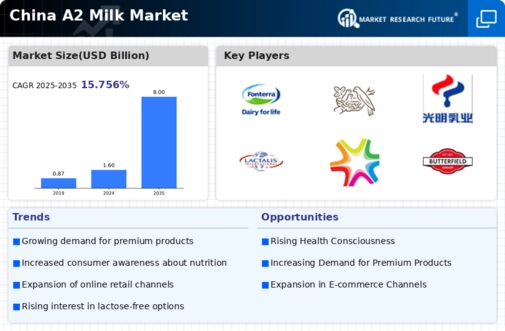Rising Lactose Intolerance Awareness
The increasing awareness of lactose intolerance among the Chinese population is a pivotal driver for the a2 milk market. Studies indicate that approximately 90% of adults in East Asia experience some degree of lactose intolerance, leading to a growing preference for lactose-free alternatives. a2 milk, which contains only the A2 beta-casein protein, is perceived as a suitable option for those who struggle with traditional milk. This shift in consumer behavior is likely to propel the a2 milk market, as more individuals seek products that align with their dietary needs. Furthermore, the market is projected to grow at a CAGR of around 15% over the next five years, reflecting the increasing demand for lactose-free dairy products. As awareness continues to spread, the a2 milk market may see a significant uptick in sales and product offerings.
Shift Towards Natural and Organic Products
The trend towards natural and organic food products is gaining momentum in China, significantly impacting the a2 milk market. Consumers are increasingly seeking products that are free from artificial additives and hormones, favoring those that are perceived as healthier. a2 milk, often marketed as a more natural alternative to conventional milk, aligns well with this consumer preference. The organic dairy segment in China has been expanding, with a reported growth rate of 20% annually. This shift suggests that the a2 milk market could benefit from the rising demand for organic and natural dairy options. As consumers become more discerning about their food choices, the emphasis on quality and sourcing is likely to drive further interest in a2 milk products, potentially leading to increased market penetration and brand loyalty.
Influence of Urbanization on Dairy Consumption
Urbanization in China is reshaping dietary patterns, which in turn influences the a2 milk market. As more individuals migrate to urban areas, there is a noticeable shift towards convenience and premium food products. Urban consumers tend to have higher disposable incomes and are more willing to spend on health-oriented products, including a2 milk. The urban population is expected to reach 1 billion by 2030, which could significantly boost the demand for premium dairy products. This demographic shift indicates that the a2 milk market may experience accelerated growth as urban consumers increasingly prioritize health and wellness in their dietary choices. The convenience of purchasing a2 milk through modern retail channels further supports this trend, making it more accessible to a broader audience.
Regulatory Support for Healthier Dairy Options
Regulatory frameworks in China are increasingly supportive of healthier food options, which is beneficial for the a2 milk market. The government has been promoting initiatives aimed at improving public health and nutrition, encouraging the consumption of dairy products that are perceived as healthier. This regulatory environment may facilitate the growth of the a2 milk market, as it aligns with national health objectives. Additionally, subsidies and support for dairy farmers producing a2 milk could enhance supply chain efficiencies and reduce costs. The market is expected to see a rise in production capacity, potentially leading to lower prices for consumers. As regulations continue to evolve, the a2 milk market may find itself in a favorable position to expand its reach and influence within the broader dairy sector.
Growing Influence of Social Media and Marketing
The role of social media and digital marketing in shaping consumer preferences cannot be understated, particularly in the context of the a2 milk market. With the rise of platforms like WeChat and Douyin, brands are leveraging these channels to educate consumers about the benefits of a2 milk. Engaging content and influencer partnerships are driving awareness and interest, particularly among younger demographics. This marketing strategy appears to resonate well, as the a2 milk market is witnessing increased visibility and consumer engagement. Reports suggest that brands utilizing social media effectively can see a sales increase of up to 30%. As digital marketing continues to evolve, the a2 milk market may capitalize on these trends to enhance brand loyalty and expand its consumer base.






















Leave a Comment